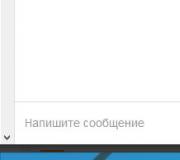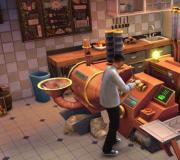Joomla administrative section. How to close the admin login of Joomla! Joomla Administrative Control Panel
From the author: Greetings, dear readers. The Joomla admin panel is the most important element of the content management system, since it creates the functionality and content of the site as a whole. This means that in this article, I would like to tell novice webmasters about this section, as well as about those tools that are available in the standard functionality.
The Joomla administrative panel is a closed section of the Joomla content management system, access to which is allowed only to authorized users who have the appropriate rights. At the same time, this section is used to configure the functionality of the CMS, install additional extensions, manage users, create modules, menus, select a template and, of course, fill the site with content. Thus, most of the work on the site, that is, its administration, is performed in this section, with the exception of code edits, although some extensions provide the ability to edit the code of individual elements.
For those who don’t know, the Joomla admin panel is located at the following address: http://domain/administrator. That is, you need to add the line administrator to the existing CMS address.

Having specified the user login and password in the appropriate fields, click on the “Login” button and if the data is correct, you will be redirected to the closed section of the CMS.

Modern trends and approaches in web development
Learn the algorithm for rapid growth from scratch in website building

I would like to note that the appearance of the Joomla admin panel may change depending on the user’s rights. That is, if the user has limited rights to visit certain sections, then, accordingly, links that lead to these sections will not be displayed.
A closed CMS section consists of individual elements, or managers, each of which is responsible for working with a specific CMS tool. For example, the user manager contains tools for creating new users, setting up the registration mechanism, editing groups and access levels, etc.
In the upper area of the section, there is the main menu of the admin panel, which contains links to available CMS tools.
Below is a dynamic work area in which, depending on the functionality of the page, a certain set of tools will be displayed. For example, the main admin page is divided into two areas. The left sidebar displays links to some sections that are most often used during administration. In the center we see statistical information about the site, information about the server and PHP language interpreter, information about authorized users, as well as the latest added and most popular materials.

The most important element of the Joomla admin panel is the CMS general settings page (System->General Settings).

There are quite a lot of settings, so they are divided into separate tabs depending on their affiliation. In addition to general settings, here are the settings of individual CMS elements, that is, components, both standard and installed additionally.
The next most important element is the material manager (Materials -> Material Manager), which is used to create and edit site content. A unit of content in the standard Joomla functionality is a material, which is essentially a simple article. At the same time, you can divide articles into separate categories, which are also created in the above manager, which is very convenient, especially if the site being created is a blog.

To manage the appearance of the site being created, use the “Template Manager” (Extensions -> Template Manager), which contains a list of templates installed in the system. Accordingly, in this manager you can select a template that will be used as the default template, as well as configure the available parameters of each template individually.

The standard functionality of Joomla, of course, is not rich and is designed to solve typical problems in website building, but at any time you can significantly expand it by installing the necessary components, modules or plugins, of which a huge number have been developed at the moment. To install extensions, there is a special tool in the admin panel - “Extension Manager” (Extensions -> Extension Manager).
From the author: Greetings, dear friend. The admin panel is an integral part of any content management system and, of course, Joomla is no exception. Therefore, in this article we will talk about this section of the CMS, and decide on a rather difficult question that all beginners ask - how to log in to the admin panel in Joomla?
For those who do not know, the site control panel or admin panel is a special closed section of the content management system that allows you to manage the content of the entire site as a whole. That is, in relation to Joomla, this section allows you to: make various settings, add, edit and delete content, configure menu items, work with users, create and display modules in the required positions, customize the appearance of the site by selecting templates, as well as expand the functionality of the CMS by installing third-party extensions - components, modules or plugins.
At the same time, as mentioned above, in Joomla, only authorized users are allowed to log into the admin panel, provided that they have the appropriate rights. That is, if a user is authorized in the system, this does not mean that he can enter the admin panel, since he may not have the rights to do so. At the same time, depending on the user’s rights, certain controls may be closed in the admin panel. That is, if the user does not have rights to create and edit materials, then these actions will be prohibited from being performed on his behalf and the corresponding elements will also not be available. Thus, depending on the user's rights, the appearance of the admin panel will change.
Accordingly, if it is not possible to create a website on the Joomla CMS without an admin panel, then the question arises - how to log into the Joomla administrative panel.
To enter the Joomla admin panel, you need to add the line “/administrator” to the site address. That is, if the address of your website is domen.ru, then to enter the admin panel you must go to the address - domen.ru /administrator.

Modern trends and approaches in web development
Learn the algorithm for rapid growth from scratch in website building


Now you know how to log into the joomla admin panel, but the proposed standard methods may not work on someone else’s site, because very often site developers hide the standard path of the admin panel for security reasons, using various third-party extensions. Since on the authorization page, an attacker can organize a password search, especially if he knows the administrator’s login. And if the password is simple enough, which is often the case, after a while he will be able to log into the Joomla admin panel, which is extremely undesirable.
If you want to learn how to create websites using the Joomla content management system, this course will be useful to you. This concludes this article. All the best to you and happy coding!!!
In this article I will introduce you to the Joomla admin panel. You will learn how to log into the admin panel, the purpose of the admin menu items and the admin control panel buttons. And so, you have installed Joomla - a content management system. Now you need to learn how to manage the site. You can easily cope with this task if you learn how to work with the site’s administrative control panel (admin panel).
In order to enter the admin panel, you need to enter the address of your website in the address bar of your browser and add /administrator at the end.
For example, a site named mysait will have the following address: http://mysait/administrator
If the address is entered correctly, an authorization window will open. You must enter your login and password. By default, the login is admin, and the password is the one you entered when installing CMS Joomla
By clicking on the Login icon you will be taken to the administrative section (admin panel). To make it easier for you to understand everything, look at the picture below. The Joomla admin window is schematically divided into three parts, let's look at each of these parts and the purpose of each Joomla menu item.

1. VIEW. In the upper right corner of the window, you see a View icon. When you click on this icon, the Home page of your site opens. This way, while creating a website, you can view the results of your creativity in the browser.
2. SITE CONTROL PANEL. Located in the central part of the admin panel. Figuratively speaking, the site control panel is a desktop on which the most necessary and frequently used menu buttons are located. Apparently, this was done for convenience, so as not to waste time accessing the items and sub-items of the top menu.
3. ADMINISTRATIVE SECTION MENU. A horizontal menu located at the top of the admin panel. In essence, the admin menu is the control panel for your site, and the submenu items are the remote control buttons. Now you need to figure out which button on the remote control does what.
Joomla admin menu
When you hover your cursor over a specific top menu item, you will see drop-down submenu items. Let me briefly describe the purpose of the admin menu items. Why not in detail? Because when you start designing and filling your site with material, you will have to constantly refer to menu items and it will be easier to understand everything as you work. I’ll write more about this later, but for now let’s take a quick look at the menu.
In the diagram below you see the Website menu (with drop-down submenu items)

I will describe the purpose of the remaining items of the ADMINISTRATIVE SECTION MENU (admin panel):
SITE - intended for website management. Working with user accounts, managing media files.
ALL MENU - designed to work with the site menu. You will be able to create a menu for your site, edit and delete menu items.
MATERIALS - intended for working with site materials. Here you can create and edit articles, upload images to them. Also, create sections and categories.
COMPONENTS - serves to establish feedback, a system for collecting statistics, voting, etc. In Joomla, the components necessary for your site can be downloaded and installed on the site. So your “Components” menu will increase.
EXTENSIONS - designed to add modules, plugins, templates, components that can significantly expand the functionality of Joomla. You can find out everything about extensions for Joomla in a separate article.
TOOLS is a menu section for a user from the super administrator (chief administrator) group. Allows you to write and view personal messages. Make mass mailings to registered users.
How to get to the control panel of the Joomla website! v. 3.x
Usually this elementary question appears among users who are just starting their acquaintance with cms Joomla! Or: after a long break in working with the site, it is quite possible to “forget” the path to the Joomla admin panel.
Time since the creation of the first versions of Joomla! a lot has passed. But the entrance to the admin panel has remained virtually unchanged. It’s all simple: in the address bar of your browser, add the word administrator to the address of your site using a slash to get:
https://your_site.ru/administrator
By clicking on the “Go to next page” button in the browser (or Enter on the keyboard), we will move to the authorization page of the administrative control panel with the form:
It is clear that you need to enter your Login, Password, Language into the text fields (if the default language choice is not obvious, usually you do not need to select a language) and then click the “Login” button.
It is assumed that you have a Login and Password (assigned during CMS installation) or were provided to you by your webmaster (who made your site). If the password is lost: try to recover it (usually it helps).
Important: It is strictly undesirable to enter your password/login from the keyboard! It is worth storing them in a text document (type *.txt - Windows Notepad) and entering them into the text fields of the form using simple keyboard commands: Ctrl-C and Ctrl-V (copy-paste).
If a password stealing Trojan has taken up residence on your computer (not every antivirus will detect it), then the consequences can be unpleasant.
It is useful to periodically change the password to a new one (random password generation) with a length of 15 characters (even if this length is paranoid, it is more reliable).
Actually, you are in the site’s Control Panel. Depending on the User Group assigned to your account by the webmaster and the rights corresponding to the group, the Admin Panel page will have a different appearance. Super Administrator has maximum capabilities.

If the Control Panel is inactive for a long time (i.e., opened and went away to smoke), then after a while you will have to log in again. The time of “inactive” presence in the site’s admin panel is determined by the Administrator.
The only fundamental feature of logging into the Control Panel is the function:
General settings -> Session settings -> General sessions

When this function is enabled, the User session is simultaneously used in the Control Panel and in the web interface of the site. This is convenient in earlier versions of Joomla! I had to log in twice: in the Control Panel and on the Website.
So, what kind of beast is this – the Joomla admin panel? In the professional circle of webmasters, this is called the admin panel or site control panel. And this lesson, as you might have already guessed, will be about it. I will introduce you to all the most important sections of the Joomla 2.5 admin panel.
How to log into the admin panel?
To enter the administrative part, you need to enter in the address bar of your browser "localhost", and then, after the name of the site, write administrator. In my case it looks like this: http://localhost/test/administrator. We fill in the required fields to log in and get to the admin panel.
Joomla 2.5 admin
The Joomla admin panel consists of seven menu items, which in turn are divided into sub-items.
- Control Panel. Here are the main control icons, which serve for quick and convenient access to the site settings. They seem to duplicate the most important menu items.
- My profile. If necessary, in this section you can change the administrator profile data.
- General settings. All necessary site settings are displayed here (name, accessibility, default editor, etc.). We will return to this section in subsequent lessons, when we make the first settings.
- Service. A sub-item in which maintenance is carried out, namely removing locks, deleting or clearing outdated cache.
- System information. Here you can find detailed information about the Joomla system.
- Go out. Everything is simple here, the last sub-item is used to exit the Joomla admin panel.
2 Menu item - Users
3 Menu item - Menu
The menu manager is used to manage all the menus on the site.

4 Menu item - Materials

- Material Manager– a sub-item in which all work with site materials is carried out.
- Category Manager— sub-item for managing categories of materials.
- Selected materials— here you can place the most necessary materials for more convenient access to them.
- Media manager - serves to easily upload various information to the site, such as pictures, audio, video, etc.
5 Menu item - Components

6 Menu item - Extensions
What extensions there are, also read in the article from point 5.

- Extension Manager. The most important sub-point. It is used to search, download and remove various components.
- Module manager. Modules on the site are managed in the module manager.
- Plugin manager. In the plugin manager section, as you probably already guessed, we will configure and edit all the necessary plugins.
- Template manager. Using the template manager, you can easily change the design of your site beyond recognition.
- Language manager. The sub-item is used to manage languages on the site.
7 Menu item - Help
1 Menu item - Website
Today in the lesson we got acquainted with the main sections of the admin panel of Joomla 2.5, but as they say: “This is just the tip of the Iceberg.” In the future, we will dive deeper and deeper into the “cold waters” of Joomla in order to study in the most detail not only the administrative part, but also other hidden secrets of site building.
If you have any questions, ask them in the comments to the article, I will try to answer you.



